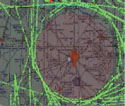Training System Models National Defense
 |
| The U.S. Air Force’s Modeling and Simulation Training Toolkit (AFMSTT) enables the service to train its personnel for a variety of missions. The toolkit recently was modified to support joint and interagency operations in U.S. airspace. |
The U.S. Air Force is preparing to defend national airspace against a variety of airborne terrorist threats such as hijacking and missile attacks. To achieve this goal, the service has modified its training and simulation software toolkit to model the crowded skies over the
The Air Force Modeling and Simulation Training Toolkit (AFMSTT) consists of a group of software applications designed to provide a range of operational environments for mission training. The software originated nearly 20 years ago as a way to train air operations center (AOC) personnel to conduct electronic warfare attacks against Soviet surface-to-air missile sites, explains Col. David Votipka, USAF (Ret.), warfighter advocate, Gestalt LLC, Orlando, Florida. Over the years, the AFMSTT was modified to provide training for all AOC activities. The toolkit is built around the Air Force’s Air Warfare Simulation (AWSM) model.
As the toolkit expanded, it was used in a variety of joint exercises as a large simulation environment. The
The AFMSTT communicates between different command and control systems to provide a representation of the outside world. The software generates the data and visuals for the AOC’s systems and mission-planning capabilities. For example, if an AOC is using a command and control tool with a data display, the AFMSTT will provide that information. The software also simulates radar feeds and other sensor data streaming into an AOC.
As the AFMSTT grew to encompass all of the systems used by an AOC, it was modified to improve operator use and to replicate the modern world more realistically. These improvements included a logistics model and techniques to reduce the manpower overhead necessary for running an exercise.
Although the toolkit has evolved into a system of systems instead of a simple model, some of its core algorithms, such as those used to model aircraft flight characteristics, have not changed. “The cores of the model are still valid and very much in use. What we’ve evolved over time and more recently are a lot of the interfaces,” says Theresa Zataveski, Gestalt’s AFMSTT program manager,
To maximize operational flexibility, the AFMSTT program team has built hooks into emerging command and control systems so it can interface with the toolkit. “We’re trying to modernize different user interface and data interface aspects—things that were done years ago over proprietary protocols. We’re trying to evolve to more of a services-based architecture and take advantage of XML [Extensible Markup Language] and some of the newer technologies available,” Zataveski shares.
Other new capabilities that the team created are homeland defense scenarios. The toolkit can model commercial as well as military air traffic, and it can create no-fly zones, which the Federal Aviation Administration (FAA) can impose during a major national disaster. “We’re trying to add functionality and capability to new real-world scenarios,” she says.
Over the last two years, the AFMSTT program has worked with the U.S. Northern Command (NORTHCOM) and the North American Aerospace Defense Command (NORAD) to support training over national airspace. Zataveski notes that in the past, key NORTHCOM and NORAD training systems were stovepiped. Some of the major command and control systems in NORAD’s
To support NORTHCOM’s requirements, the AFMSTT program built in a variety of capabilities to the software upfront. Zataveski says that the ability to establish and enforce a no-fly zone over the
 |
| The AFMSTT software allows users to simulate the implementation of a no-fly zone over a disaster area. |
The AFMSTT team also worked with the 1st Air Force located at Tyndall Air Force Base,
Col. Votipka notes that the 1st Air Force had almost no broad training capability that could work across different agencies, but he adds that the organization has now greatly expanded its joint and interagency training capability. During a real emergency, he explains, controllers and commanders will have to make vital decisions while thousands of people are in the air. Because of the importance of the work, the training simulation had to mirror the complexity of the national air picture so that training participants could practice realistic interagency operations. “That’s a tremendous improvement. It’s something that hasn’t been looked at for decades. They had to learn how to handle an emergency that requires the coordination of everyone from the president of the
The AFMSTT toolset is used in 14 major annual exercises, most of them with joint service components. Col. Votipka explains that the software is not a separate model so much as an added capability that supports a virtual training environment. The new airspace modeling capability was demonstrated in exercise Ardent Sentry in 2007. This event was the first use of the new civilian flight pattern capability. Zataveski says that work is ongoing to support and enhance this new application, adding that additional capabilities are being developed for delivery at next year’s Ardent Sentry.
According to Zataveski, the AFMSTT team has received good feedback for its work. She explains that the multiagency after-action review of Ardent Sentry was positive and that this exercise was the first large-scale integrated training these organizations had received. She maintains, however, that much work still has to be done, which is why Gestalt is focusing on developing new capabilities to deliver.
Prior to using the AFMSTT, national defense exercises were conducted on tables or face to face. But operating in a simulated environment allows participants to make real-time decisions. Col. Votipka notes that the goal of complex exercises such as Ardent Sentry is to understand the procedures and processes necessary to undertake a real-life scenario. “There’s nothing that concentrates the mind like seeing an aircraft on your display fly toward
Based on the feedback from the exercise, the AFMSTT team is adding missile characteristics into the simulation, which enables participants to model missiles in flight. This application is being tested at Peterson Air Force Base,
The toolkit is being modernized under the Network Enterprise Services Infrastructure (NESI), which is a set of guidelines outlining how to manage network-centric applications. Zataveski says that many system interfaces traditionally have been proprietary. To overcome these old stovepiped systems, over the next year the program will be adding more service-oriented architecture components and data services within the applications. She explains that this modification allows the system to follow commercial best practices and interfaces.
The program also is trying to evolve using common data schemas. In the past, the service ran a mix of schemas. Zataveski adds that the program is trying to move to systems such as Cursor on Target, which is a universal core standard for the Air Force. “We’re trying to do some data standardization by bringing the interfaces up to some commercial open standard architectures. We’re doing that by combining our experience in the commercial world with our knowledge of the Defense Department to make sure that we don’t break anything in the existing models and that we can still connect to all the same command and control systems in a way that’s scalable for the future,” she says.
Under this evolutionary approach, if one of the system’s underlying data components is replaced, a more modern technology can be inserted in its place. Col. Votipka notes that the NESI guidelines are designed to modify legacy systems such at the AFMSTT and bring them up to network-centric standards. “A lot of people think: ‘We’ve got an old system. We just need to start from scratch and rewrite everything.’ There’s 20 years of corporate knowledge embedded in the code of this thing. The real thing is how to modernize it while it’s still being used, and NESI gives us the ability to do that,” he says.
Web Resources
Gestalt LLC: www.gestalt-llc.com
North American Aerospace Defense Command: www.norad.mil




Comments